

Back and forth, hither and yon – whether on my habitual trajectory between Touraine and Paris or further afield… destinations, encounters, events and observations I can’t resist sharing.

In 1955 when American heiress Marjorie Merriweather Post purchased the 25 acre Hillwood Estate in Washington DC, she remodeled the house and gardens to reflect her passion for European decorative arts and landscape design. Upon her death Post bequeathed the house and collection to the public, and the museum provides a window onto the world of the original owners of the art as well as the lifestyle and taste of the woman who collected it.
The mansion’s reception rooms showcase Mrs Post’s collection of French and Russian imperial 18th and 19th century paintings and furnishings. Portraits of French and Romanov royals survey the Louis XVI furniture resplendent with marquetry and gilded brass, Sèvres porcelain, Beauvais tapestries and Fabergé eggs.

The much married heir of midwestern entrepreneur C.W. Post, founder of the Postum Cereal Company, looked to America’s eastern establishment and European aristocracy to fashion her identity and ambiance of her home. The result is a bit of an aesthetic hodgepodge. When well advised by influential art dealers like Sir Joseph Duveen, her purchases were sure, but left to her own devices she veers into pastiche. Glamour portraits by contemporary artists of she and her daughters (including hollywood actress Dina Merrill) dressed to the nines, dripping in jewelry and frippery are pretty dreadful.
When wealthy Americans try to emulate historic European homes and decor it inevitably comes off as false. The patina is missing. Not enough dust balls, worn parquet and frayed upholstery.

The real treasure at Hillwood is the kitchen and pantry. Talk about authenticity. 100% American ingenuity. Julia Child would think she’d arrived in heaven. After her father’s death, Mrs Post became involved in the family business and her second husband businessman Edward F. Hutton acquired Birdseye frozen food as part of a series of acquisitions that transformed the company into General Foods.
The kitchen and pantry are models of 1950’s modernity. Each utensil and appliance is left in place as though the staff are about to show up to prepare for the next function. For foodies and lovers of Americana it’s not to be missed.

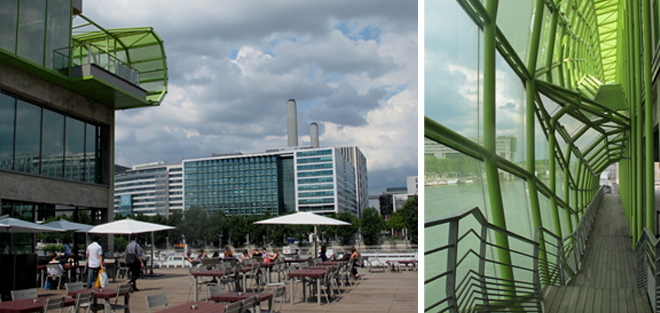
Paris has a new fashion temple on the Seine – Les Docks, Cité de la Mode et du Design – between Gare d’Austerlitz and the BNF. Another style scoop for the Left Bank’s eastern waterfront.
The undulating lime green facade is hard to miss from the opposite bank. Architects JAKOB+MACFARLANE created a diamond pattern ‘Plug-Over’ for the existing industrial dock building. Goals of the state-funded project include attracting visitors besides the fashion/design tribe, and furthering the city’s reputation as world fashion capital. Outdoor space is expansive, with wooden decks on the street and roof levels. Plenty of seating is provided for sunning, sipping drinks and surveying river traffic.
It’s an ambitious 4-story complex encompassing a museum/gallery, conference & showroom space, offices, boutiques and 4 bar/restaurants. The MoonRoof quickly became a hot RDV for drinks and celebrations. A sprawling deck surrounding the surprising vegetal roof offers spectacular river views.
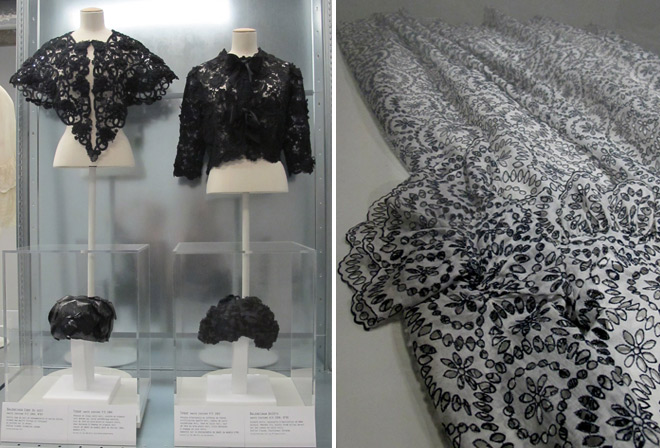
The MUSÉE GALLIERA HORS LES MURS has a duet of shows through October 7 featuring past and present couture innovators:
Cristobal Balenciaga – Collectionneur de Modes
White Drama – Rei Kawakubo for Comme des Garçons
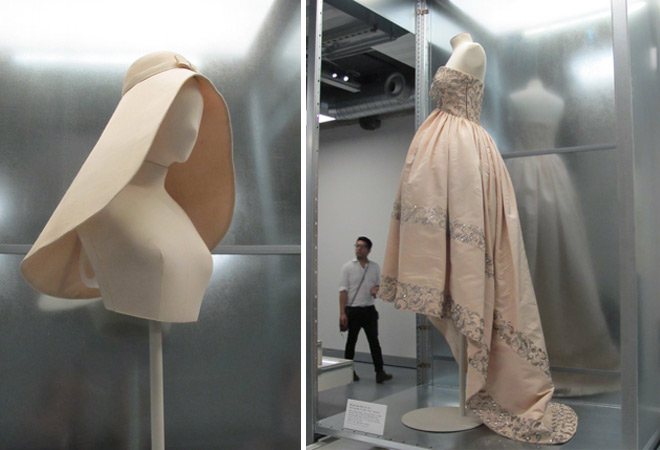
The Balenciaga exhibit marks the 40th anniversary of the Spanish couturier’s death. It showcases 40 garments created between 1937 and 1968, alongside his private collection of 18th and 19th century fashion, costumes and accessories. The juxtaposition demonstrates how folkloric costumes and 19th century fashion inspired his work. The installation is a bit disconcerting – with couture pieces on mannequins above cantilevered drawer display cases. I’d prefer seeing the gowns at ground level, visible from several vantage points. Looking up at clothing is not a flattering angle. One of several exquisite Balenciaga hats – a sweeping sculptural bridal model, was reprised in the 2012 Balenciaga spring-summer collection.
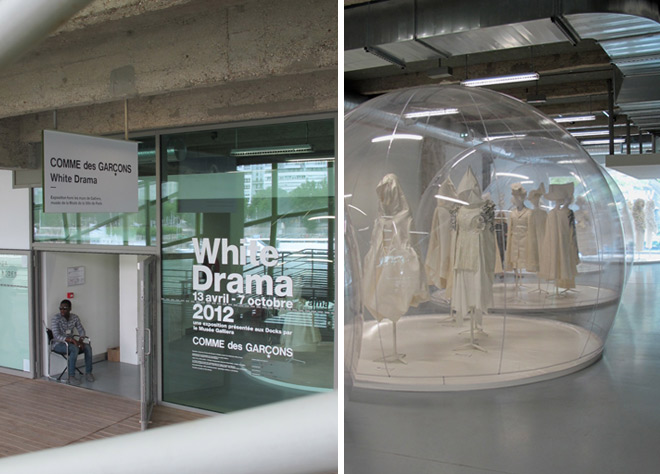
While the couturiers’ couturier leaves you with visions of black lace mantillas, the accompanying show of Rei Kawakubo’s 2012 spring-summer collection, is a blizzard of creamy white. Mannequins are grouped by theme in plastic bubble tents. The effect is eerily poetic. Her runway show received glowing reviews; a moving spiritual parenthesis amid a succession of commercial collections.
Striking parallels exist between the two exhibits – sculptural form married with decorative embellishment, solid colors versus prints, gathered seaming and substantive fabrics that imbrue garments with ceremonial solemnity.
Left feeling I’d been witness to rituals conducted by a high priest and priestess of fashion.
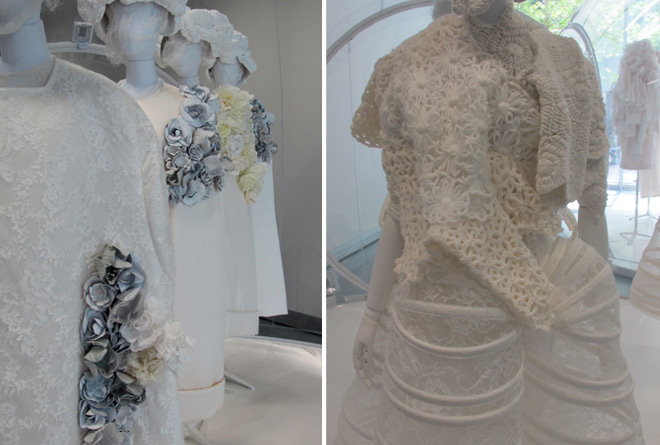

Just back from the department of Finistere on the southwest coast of Brittany. It’s a good thing the scenery is gorgeous because Brittany weather is consistently wet and windy. I did catch 2 sunny beach days at Pont-Aven one summer, but the sea was so cold it gave you a headache. If you thrive on the bracing coastal romance of Maine, Nova Scotia, west of Ireland and Scotland, then Finistere is for you.
The holy grail of windswept scenery is La Pointe du Raz, beyond the village of Plogoff – a rocky promontory notorious with sailors for intimidating waves and deadly currents. Tourists were kitted out in hiking sneakers and anoraks with a hood. It was far too blustery for an umbrella or a rain hat, unless tied tight under the chin (not a winning look even for babies).
Pointe du Raz is France’s Land’s End, and became a major tourist destination after Victor Hugo and Gustave Flaubert extolled its savage beauty. “Here is the end of the old world; behold its outer limit. Over your shoulders lie all of Europe and Asia; in front of you the ocean, the endlesss ocean.**” Technically Flaubert got it wrong, as there are two other Brittany outcroppings that extend a tad further into the Atlantic, but neither has comparably sublime scenery.
When crowds needed to be reined in at the risk of destroying the fragile ecosystem, Raz was designated a protected national park – one of France’s not-to-be-missed “Grand Sites”. Today’s pilgrimage is an orderly, didactic affair involving paid parking, a show-and-tell visitor’s center and jitney bus ride for the tired, infirm, lazy, or anyone who hopes to keep their hair looking good. On a clear day you can spy the low-lying island of Sein, just 5km offshore. Sein is a hardy fishing community with neither cars nor protected harbor, now threatened by rising sea levels. The sea was too rough for ferries to dock the day we were there.
Finistere is the cradle of Basse (or low) Brittany culture. Basse refers to the western half of Brittany, where most locals spoke only Breton before it was outlawed in 1902. An unofficial border has existed since the 14th century between the Basse and Gallo (French speaking) eastern half of Brittany. The Celtic language formerly spoken in the west, is now being revived in bilingual schools throughout the peninsula, and promoted through numerous cultural associations and institutions, yet a mere 5% of the population (206,000*) speak it fluently.
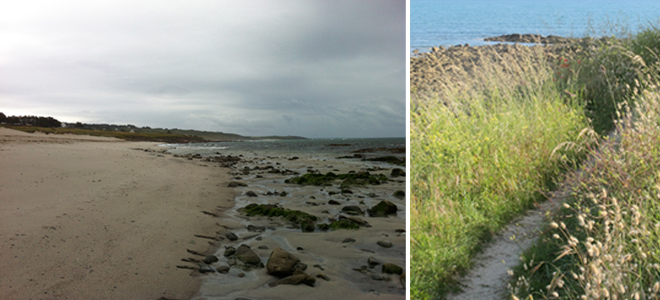
The profile of a typical Bretonnant speaker is a retired married woman with no educational degree living along the Finistere coast. Her husband was likely a fisherman, farmer or manual laborer and chances are that her children understand the language but don’t speak it. Ironically, the generation who speaks fluently is conflicted about Breton’s importance, as their parents (many of whom didn’t speak fluent French) were stigmatized as being primitive. What is now being taught in bilingual schools, and spoken on radio and TV, can be difficult for them to understand, as they speak more of a patois.
The statistical trend isn’t promising for a living language, with less than 2% of school children enrolled in bilingual school and just 3% of parents transmitting it at home. However, the reality of a language in decline hasn’t tarnished its stature as a symbol of regional pride.
We tuned into a Breton station for a few hours, and concluded that it’s unintelligible to French and English speakers. The only word I picked up was the German sounding “Ya” for yes. Breton most closely resembles Welsh, and like Wales, Bretons identify strongly with their traditions. Much of their identification is tied to a mythic past and heroic traits or stereotypes like rugged individualism and connection with nature.
Bretons describe themselves in the third person as independent characters that are stubborn, rebellious, hard working and sensitive. Having grown up in an Irish American family, I recognize the disconnect between talking the talk and walking the walk. If I’d proposed studying Gaelic instead of Latin or French, my parents would have told me to have my head examined. Speaking with a brogue was a stigma, just as having a Breton accent is tied to a lingering sense of inferiority among many elderly Bretonnants.
Unlike the Pays Basque, Brittany isn’t battling for autonomy or the sort of institutional independence Catalonia won in Spain. There’s a stronger sense of community here than in other regions of France, but also less xenophobia. Brittany voters have historically rejected the National Front party and tend to vote Socialist. While the rest of France considers the Brittany peninsula somewhat remote, Brittany has never perceived itself as isolated. The sea has always been its highway and its ports have welcomed visitors from Spain and the British Isles for centuries. It is closer to to England than Paris.

Plouhinec west of Quimper was our second Brittany filming destination. I tested Air BNB and found a modest three-bedroom house overlooking a sandy cove, down the road from the fishing port of Audierne. Stringent coastal zoning no longer permits construction close to the shoreline, but the owners of the house we rented are seeking permission to add on a needed second bathroom on the upper floor. With that addition, I would highly recommend it for two couples or a family with small children. The location, delightful view and price can’t be beat, and for those who enjoy cooking, the kitchen is well equipped. A Franco-British couple owns it and Sue the booking member of the couple and her trusty housekeeper couldn’t be more accommodating. Read More »

Competition in the haut olive oil category is on a par with fine wine.
Top of the line French oil is from Provence*, and one savvy producer – Chateau d’Estaublon – is carving a niche straddling the fragrance and food categories. The minimalist spray flacon and carton are inspired by Chanel perfume, and the description “hints of fresh cut grass with a slightly fervent finish” made me want to spritz it on my neck.
They suggest spraying it on vegetables, salad or fresh pasta. The flavor is light and quite delicious.
I received mine as a hostess gift from a chic Parisian woman. It is so quintessentially French that it may become my go-to-gift to bring over when visiting friends in the States.
For the moment is is distributed in the US by World Harvest Foods of Missouri, but their mark up is surprisingly steep. Must have something to do with weight of the thick glass. Best to hold off until your next visit.
*The official appellation is AOP les Baux-de-Provence.

Beyond broad beaches of fine sand and gently rolling waves – 3 reasons not to miss this gracious seaside town in the Médoc wine region:
Just when you’re convinced there can’t be more hidden treasure along the Atlantic coast – you hit on a sleeper like Soulac. Why didn’t I know about this place? 100 kms north of Bordeaux and a hop across the Gironde estuary from Royan – it merits better name recognition. Soulac has the architectural potential to be a mini Savannah or South Beach of the French Atlantic coast, yet remains a little known family resort.
Arriving from the north or east, the easiest way to get there is a 30-minute car ferry from Royan. Leave time for a quick tour of the city. Royan is a brilliant white-painted concrete 1950’s time capsule. The old city was obliterated on January 5, 1945 by Allied carpet-bombing intended to annihilate intransigent Nazis. A massive urban renewal project attempted to compensate for thousands of citizens killed due to tragic miscommunication between an American general and the French military concerning evacuation.
A scenic alternate route is up the peninsula via Bordeaux. The winding road along the Gironde Estuary traverses fabled Chateaux vignobles – Margeaux, Latour, Mouton-Rothschild and Lafite – ending in Saint Estèphe, before leaving the undulating Haut Médoc terroir to enter the marshy flatlands of Médoc.
The landscape is a mixture of sand dunes and scrub pines on the ocean side, and marshland along the estuary. The eastern shore is scissor cut with minute tidal ports, where modest pleasure and fishing boats keep company with cabanes de pêcheurs cantilevered over the water on stilts. The most picturesque to my taste is Port de la Maréchale next to St-Seurin-de-Cadourne.

In mid March, Soulac was emerging from winter hibernation. Its population of 3,000 expands July through August to 55,000, but tourist season builds up slowly. My first hotel choice – Hôtels des Pins in Amelie Beach at the southern edge of town – opens in April, so we settled for Hotel Michelet, a small 2 star a block off the oceanfront. The establishment is impeccably clean and professionally run, but shrill décor, circa 1995, is hard on the eyes. Imagine the decorating section of a DIY homestore like Leroy Merlin.
The Michelet’s central location, plus sea views and a balcony in chambre 10, compensated for clashing color schemes. Philippe the proprietor couldn’t be nicer or better intentioned – even going so far as to deliver a breakfast tray at seven am.
Our Lady of the Ends of the Earth is an apt name for the Romanesque Basilica nestled at the heart of town. Back when Saint Veronica (buried in the church) was proselytizing the Gironde peninsula, the former Benedictine abbey at its tip was indeed remote. Were it not for occasional passage of St. Jean de Compostel pilgrims crossing the Gironde estuary, it would have been completely ignored.
Over the centuries, Soulac fell into obscurity as the dunes encroached on the Basilica to the point of swallowing it up. By the 18th century, farmers drove metal rings into the barely protruding stone towers to attach livestock. Today, pines teetering over the edge of the sandy cliff above Amelie Dune testify to ongoing errosion, and make it possible to imagine how a monastery could be engulfed over the centuries.

In the mid 1800’s, the fashion for bathing cures accelerated development of ‘Soulac-les-Bains’, and construction began of its charming Côte d’Argent style villas. Escavation and restoration of the Basilica in 1860 brought more visitors. A second wave of villa construction followed in the early decades of the 20th century with a more idiosyncratic ‘post colonial’ vernacular featuring turrets, pavilions, jutting wings, balustrades and porches. Lacey punched wood fretwork and terracotta roof tiles were de rigor, along with brightly hued painted wood trim.
Colonnaded first floor balconies evoke the architecture of French Caribbean and African island colonies. Each villa has a romantic or sentimental name enshrined on painted tiles, carved stonework or cursive script under the peak of a central eave above the front door. Stop by the Tourism office (next door to the cinema) for times of guided tours offered in several languages.

Ten to 15 years ago, a vintage gingerbread brick villa could be had for 40 thousand euros, but now a 75 m3 cottage & garden requiring work, sells for €350M (still a bargain by Cap Ferret standards, where a characterless shack goes for significantly more). Buyers are primarily French, while tourists are German and Dutch, with a smattering of British.
On your tour of centre ville, don’t miss the handsome market building. Its cavernous hall is filled with rows of food, wine, florist and flea market stalls. A side wing is devoted to fish and seafood. Open daily year round from 8am to 1pm, and again during July & August between 5 and 8 pm.
Restaurant choices in March were limited, especially midweek, but it’s evident that plenty of variety exists for summer vactioners. Tables on the glass veranda of Le Grill Océan on the Front de Mer enjoy an idyllic view of sunset over the beach – just the place to marvel at the conjunction of Venus and Jupiter in the velvet night sky on March 13. For seafood lovers, a €25 dinner menu includes large fresh oysters or a tureen of terra cotta hued fish soup as a starter, and grilled dorade or mussels in cream sauce for the main course. Desserts are homemade. Inexpensive white Bordeaux and Côte de Gasgones on offer. A 2009 Château de Teste provided a satisfying switch from Loire Valley white. La Villa Soulacaise, also recommended by our host, was closed for dinner.
The surprise of the visit was coming upon a replica of the Statue of Liberty perched atop a pedestal at the north end of ocean drive. It arrived clandestinely in Soulac in 1941 when French rail workers intercepted a train shipping it from Bordeaux to Germany, where it was destined to be melted down for armaments. In Bordeaux the statue had been the centerpiece of a giant fountain in Place Picard, but after the war Soulac held on to her.

Following Liberty’s gaze toward the horizon, you’ll spot the iconic silhouette of Phare Cordauan. Built in 1611, it is the oldest French lighthouse in service and the last to be inhabited full time. The lavish interior includes a chapel where weddings and baptisms take place. Nicknamed the Versailles of lighthouses, Cordauan is accessible at low tide on foot from neighboring Le Verdon-sur-Mer, if you are up for a 7-kilometer hike across the sand bar.
It’s hard to project how Soulac’s genteel ambiance is affected by summer crowds. In the old town center, streets are narrow and can’t handle much car traffic. Locals I met claim it remains off the radar despite development of the huge Médoc marina complex nearby, capable of harboring large boats.
The square and adjacent sidewalks in front of the Basilica were being renovated under supervision of historic preservation, so access roads were sealed off with metal grills. I managed to squeeze through a gap in the fencing and approached a group of stonemasons to inquire if the church was open. None of them spoke French, so I tried English and one happily spoke up. Not surprisingly they were Portuguese. Sadly the church was closed but they had no problem with me wandering around and I was able to admire exceptional carved stonework at the back. Another excuse to return in warmer weather to better sample Soulac’s ample charms.

The French Atlantic coast trends to melancholy midwinter, but Hendaye on the Spanish border is an exception. You know you’ve landed in a surfing mecca if it’s January, barely above freezing and pelting rain, yet dozens of neoprene-hooded heads are bobbing in the breakers. Seafront parking is jammed until sunset, when the diehards reluctantly emerge from the waves, and peel off wetsuits right on the street in their haste to get into something warm and dry.
Hendaye has a health-conscious, sporty vibe – with a steady passage of cyclists, runners and hikers rounding the harbor, beachfront and vertiginous corniche road tracing the coast up to St Lean de Luz. People are out and about at all hours, even if it’s just walking a dog along the waterfront.
Hikers know it as the Atlantic departure point for the ambitious G-10 trail, which crosses the Pyrenees to the Mediterranean along the Franco-Spanish border. Thalasso-spa Serge Blanco, which was closed for renovation, is also a popular draw.
Hendaye lies on the north bank of the Bidossoa River, where it meets the sea at the Bay of Chingoudy. The Spanish town of Fontarabie is across the bay to the South, and the massive Deux Jumeaux (Two Twins) rocks rise up from the sea below the cliffline to the north.
The well-protected harbor permits pleasure boats to dock year round. There’s also an active fishing community of open sea vessels and anglers off the jetty. Didn’t see any sailboats in action but a club of rowers showed up at dusk to practice off the fishing dock, while kayakers meandered around the bay.
A mere trace remains of historic L’Isle de Faisons, rendezvous point for royal and diplomatic exchanges over the centuries between Spain and France because of it’s strategic, face-saving location off the mainland. In 1526, Francois I was traded for two of his sons after being captured at the siege of Parvis, Anne of Austria, bride of Louis XIII, entered her new country here in 1615, and in 1660, the marriage contract of Louis XIV with the Infanta of Spain was signed in a pavilion designed for the occasion by Velasquez, as a term of the treaty which concluded 30 years of warfare between the rival nations.
The town is divided between Hendaye-ville (train station, town hall, businesses and principal shopping district) and leisure-centric Hendaye-plage (beach, port de peche, port de plaisance, thalasso, hotels and casino).

We stayed at Villa Goxoa, a pleasant family run micro hotel on a magnolia-lined residential street, equidistant between the beach and harbor. Owners Nathalie and Marc Applagnat inherited the house and gutted the interior three years ago to create a minimalist contemporary nine-room hotel. Rooms are small and lack a bit of character, but impeccable, with comfortable beds, good sheets and pillows. Several have a small balcony or terrace. Bathrooms proportionately bigger and well appointed, though only one double is equipped with a bath. Satisfying breakfast of OJ, yogurt, fresh fruit salad, croissants, baguette, whole grain bread and a pot of strong coffee. Off-season, a double runs €85-95 euros, plus €10 for breakfast. Read More »

Never made an effort to visit Nice. When you live in Europe long enough, certain destinations like Ibiza or Prague acquire inevitability – you presume you’ll get there eventually. It took 25 years for an invitation to celebrate a friend’s birthday to make it happen. Unseasonably hot weather intensified tourist density, but the city’s irrefutable charm trumped my Cote d’Azur phobia.
Reality matched the improbable cover of a brochure titled “Nice, a natural brilliance” picked up at the airport – featuring a salmon pink building with sunflower window trim and mint shutters, silhouetted against an azure sky behind a fringe of palm fronds. At sunset, certain buildings seem lit from within. Graced with miraculous light, the lemon, ochre and terra cotta facades adorned with delicate stucco manage to appear elegant rather than garish. The mixture of 19th century and deco architecture reminded me of Montevideo, as does the sinuous Promenade des Anglais tracing the waterfront.
Wish I’d experienced Nice before it was France’s number two tourist destination, when the tropical bravura was still leavened with a patina of melancholy. Summer stretches from May through October and the balmy winter keeps people coming right through. Heavy pedestrian traffic made it hard to fully appreciate gracious Place Masséna, the old town and waterfront – the way viewing a masterpiece across three rows of shoulders in a museum is dissatisfying.
The historic old town isn’t drained of residential vitality. Locals still shop and gather in cafes lining the narrow shaded streets below the citadel. The famous flower market running parallel to the shoreline is worth a visit. Also recommend the vélo bleu, Nice’s answer to the Paris Velib bike rental circuit. I challenge you to make it up the hill to the Matisse museum – a true three-gear feat.

Sunday morning I witnessed quite by chance a frankly outrageous religious celebration in the Basilica Cathedral of Sainte Marie–Sainte Réparte. October 5th is the feast of Sainte Fleur, the patron saint of florists and since 1996, it’s celebrated on Sunday closest to the date. My first impression seeing the riot of red, white and green floral arrangements was that I’d crashed a mafia wedding. The display was so over the top, adorning every conceivable focal point. Several priests concelebrated mass surrounded by five flower-bedecked beauty queens seated facing the congregation with rapt smiles on their meticulously made up faces. It was like watching mass on a carnival float. Four of the Femmes-Fleurs represented the seasons, and a stunning blond in royal blue trimmed with golden yellow blooms, represented Nice-la-Belle. The cut flower industry is big business in the region and the event felt like a feast cooked up with the chamber of commerce. A priest at the end of the service thanked the 30 participating florists and of course the mayor. Turns out this was the main event of an annual two-day Fête de la Sainte-Fleur festival.
The diocese of Nice is clearly in the vanguard creating special events to draw in the faithful. The Sunday edition of Nice Matin covered the benediction of hundreds of portable phones earlier in the week on the feast of archangel Gabriel, patron of communication. When questioned whether his blessing had the support of senior clergy, father Gil Florini happily reported that his bishop texted approval. This week, pets are invited on the feast of Saint Francis.
Bravura and extravagance are synonymous with France’s most southern and Italian city. Long property of the King of Sardinia, it was annexed by France in 1860 and has been colonized since by generations of British sun seekers. A weekend with the distractions of a birthday celebration was far too brief a visit. Looks like I’ll be returning, but preferably in March or November.

La Part des Anges: Found on lefooding.com. Wine bar favoring natural producers, with daily menu featuring fresh local, organic and artisinal produce. Rustic décor, relaxed ambiance & friendly welcome. Lunch, Monday-Saturday. Dinner, Friday & Saturday. Limited seating, so reserve for dinner.
La Pizza (Cresci): Nice’s oldest pizza restaurant in business since 1956. Wood-fire oven, unpretentious décor & terrace on pedestrian street. Recommend the aubergine. Arrive with an appetite.
Birthday celebrations were held at two chic eateries: dinner at La Petite Maison in the old town, and lunch at La Guérite on Ile Sainte-Marguerite, the larger of iles de Lérins in the bay of Cannes.
Hard to judge a restaurant from fixed menus served to 80 guests, but the settings were fun and libations flowing. La Petite Maison seems a tad spoiled by success, but La Guérite, enjoys an idyllic pied dans l’eau setting on the quiet side of the island. The scenic boat ride from the Nice port takes an hour.
I asked Rodolphe to suggest four varieties to create a cheese plate for a dinner party. French cheese is classed into five main families, so I was limiting him somewhat. He might have preferred I said five, so he could pick one from each family.
Rodolphe begins by saying “At that time,” meaning “at this time of year (i.e. spring),” and goes on to propose several options for each of the first three selections.
Suggestions by family :
Chèvre/Goat – Couronne de Touraine or Pouligny.
Croûte Fleurie/Soft Ripened – Saint-Félicien, Saint-Marcelin or Brie de Meaux.
Pâte Pressée cuite ou non cuite/Cooked or Uncooked Pressed – Comté (cooked), Salers (uncooked), or Saint-Nectaire (uncooked).
Bleu/Blue or Croûte Lavée/Washed – For the fourth recommendation, he suggests including either a blue such as the Roquefort he has on the plate in front of him, or a washed (pronounced wa-shed in the film). Munster, Livarot, Maroilles and Epoisses are from the washed (croûte lavée) cheese family. They tend to be golden or orange in color and have a pungent aroma, although the taste is not as strong as the aroma suggests.
His specific recommendations for another time of the year would be different but he would still select one cheese from each family.

Along with wine making, the French cheese industry is undergoing a back to basics renaissance, marked by renewed appreciation for authentic flavor and organic process. As with natural wine production, which respects the idiosyncrasies and inconsistency of terroir, a new generation of cheese producers, refiners and sellers are putting science back in service of nature.
Rodolphe Le Meunier epitomizes the new vanguard. At 35, he doesn’t have much left to learn about cheese. Since 2007, he’s collected an impressive set of awards, including Meilleur Ouvrier de France, which is the gastronomic Pulitzer for food artisans, and the International Caseus Award – the Olympic gold of the cheese world.
He and his sister Caroline are the third generation to run Les Fromages du Moulin in La Croix en Touraine, between Tours and Amboise. Instead of making goat cheese and selling it at local markets as their grandmother did, Rodolphe uses his expertise to identify the best French and European cheese, which he then ages in cold storage until it’s ready to be sold. To guarantee that every cheese arrives at its destination in perfect condition, Rodolphe added a distribution and export business – From’europe – located in the Rungis wholesale market outside Paris.
Le Meunier has a profound appreciation for how well nature gets the job done if the conditions it requires are respected. The title affineur (refiner or cheese ager) gives a false impression of his role, since cheese matures with or without human intervention. His job is to create the optimum environment by controlling temperature, humidity level and air circulation, all the while carefully surveying how things are progressing. “It’s the same with wine. Storing it in an insulated wine cellar will produce better results than allowing it to age in a warehouse where temperature and light isn’t controlled. Either way, the wine in the bottle continues to evolve, but one will taste much better than the other.”
Like French celebrity chefs and winemakers, Le Meunier is leveraging his reputation to diversify his business and expand reach. Increasingly, the cheese and butter he exports to New York and Japan are marketed under the Rodolphe Le Meunier brand. The classic package design features a label with his signature, three gold fleur de lis and the distinctive MOF medal. Among his American clients is Wegmans, an 80-store mid Atlantic food market, ranked by the Food Network and Consumer Reports as America’s best grocery chain.

Le Meunier cheeses are produced in partnership with select cheese makers he’s identified as best in their class. Few producers he’s approached have turned him down. His partners are pleased to be singled out by a discerning judge in a field crowded with competitors. Le Meunier functions as product development and marketing consultant as well as distributor. His association permits independent producers to introduce their cheese to markets they otherwise wouldn’t have the opportunity or inclination to reach. “There are so many wonderful French cheeses that aren’t consumed outside of France. Certain goat, sheep and soft ripened cheese are tricky to export because they need to stay moist yet breathe in transport. The solution is airfreight but even then you can’t risk delivery taking more than three days.” He also sells to French supermarkets, but circumvents the distribution chain, which can be fatal for fragile cheese, by delivering direct to stores.
If you’re a cheese lover like I am, it’s an infinitely fascinating subject and I arrived at our meeting with tons of questions and a fair number of, as it turns out, wrong assumptions. The first myth dispelled is that buying cheese with the AOC label (Appellation d’Origine Controllé) or AOP as its EU name has become (Appellation d’Origine protégée) is an assurance of quality. “AOP tells you a cheese is made in a certain location using a particular method, but guarantees nothing in terms of quality. It’s the quality of milk used and who is makes the cheese that determines whether it’s good. Again, like wine, there are great cheeses without an AOP label, and inferior cheese with one.”
Mold is a good sign on ripening cheese. “Fuzz is natural. If it doesn’t grow on the skin of cheese, it’s pasteurized. On a soft ripened cheese like Saint Marcellin, it’s so fine you don’t see it but it’s there.” You might not like the taste, but it’s perfectly ok to eat – it’s a question of preference. “Some people don’t like the rind on Brie, but if the cheese is a good one, it’s delicious.”
Not every cheese needs to breathe while aging. Some washed rinds like Maroilles or Epoisses, are aged wrapped in plastic, to make them creamier. Even so, the cold storage room for this cheese family had a particularly pungent odor. The aroma of the goat cheese room was also memorable, but the cold chamber lined in Austrian terra cotta bricks where his pressed cheese age, was pleasant.
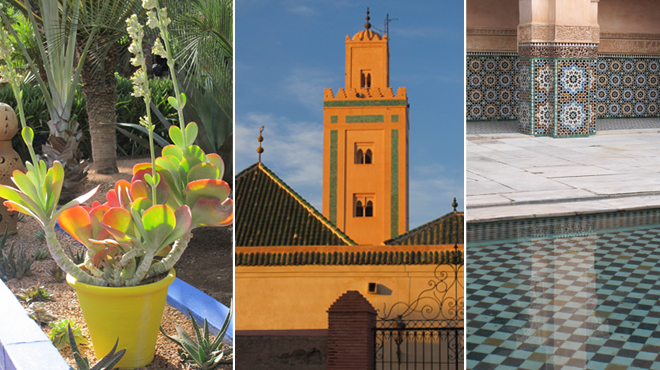
Just back from Marrakech celebrating New Year with family. It was my third time there (prior trips were sixteen and thirty years ago), but first chance to explore a full week. It’s changed considerably since 1994 – the transformational pace much faster than between my first two visits. Loss of authenticity is somewhat compensated by a boost in creature comforts.
The resonating experience of this trip was a flagrant disconnect between codes of dress and comportment within the walls of the medina and outside in the former French quarters – Guéliz and Hivernage west of the old town. Shuttling back and forth induces microseism culture shock.
We rented a riad in the Kasbah section of the Medina, next to the Mosque, Saaidian Tombs and Royal Palace – a neighborhood where alcohol is verboten, most women wear a headscarf if not a veil, and both sexes never expose a bare arm or leg. The scene is very different around Guéliz Plaza in the Zara, Mango and Etam fast fashion chain stores – where Moroccan women wear tight jeans tucked into high healed boots and toss around manes of hair. Neighborhood clubs and restaurants like Café de la Poste, Lotus, Jad-Mahal and Comptoir exude a glitzy San Tropez party vibe, with pulsating music and extensive cocktail menus.
Our driver/guide Mohamed, claimed that a third of tourists never penetrate the Medina and remain sequestered in outlying resorts, playing tennis or golf and lounging around the pool.
I left with an eerie premonition that Marrakech 2011 has much in common with Havana circa 196O, or Beirut 197O, before Revolution and Civil War crashed their parties. Perusing Nassim Nicholas Taleb’s The Black Swan: The Impact of the Highly Improbable may have gotten to me (despite an inability to slog through it). The Lebanese born author describes how well connected family and friends were sideswiped by the cataclysmic changes brought on by civil war and hovered in deluded exile, anticipating imminent return to life, as they knew it. Ditto for Cuban elders in Miami.
There’s also a whiff of Dublin’s ghost estates. If you drive out into the Palmeraies, resort properties and golf courses are going up cheek by jowl. It doesn’t take more than a few miles of cruising to detect a threat of serious over capacity. Legislation was recently passed barring foreigners from purchasing property that isn’t part of a development. It seems individual investors were jilting politically connected developers for a crumbling riad or rural kasbah. Like diaspora Irish lured during the Celtic tiger bubble, Marrakech real estate is heavily promoted to Beurs and Moroccan born Pieds Noirs. Ads at the airport pitch “return to your roots” investment opportunities “your holiday home for 100,00 dirham” (roughly 9,000 euros).
Grim foreboding aside, you can have plenty of fun in Marrakech. A dividend of steady tourism and satellite dish globalization, is a reduction in the onslaught of proffered wares and services, plus women are not as heckled with “hey gazelle” (although my daughters are a better judge of that). Read More »
© Copyright 2024 Casey O’Brien Blondes - Privacy Policy | Design by Weller Smith Design
Do NOT follow this link or you will be banned from the site!